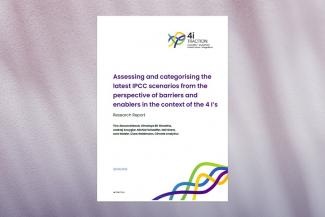
Aboumahboub, Tina, Himalaya Bir Shrestha, Andrzej Ancygier, Michiel Schaeffer, Neil Grant, Lara Welder, and Clare Waldmann (2022): Assessing latest and categorising IPCC scenarios from the perspective of barriers and enablers in the context of the 4 I’s. 4i-TRACTION Deliverable D 1.3. Climate Analytics Institute; Berlin
Assessing the Latest IPCC Scenarios From the Perspective of the 4i’s
This report assesses and categorises selected scenarios from the IPCC Special Report on 1.5°C from the perspective of barriers and enablers in the context of the 4 I’s.
Achieving the long-term temperature goal of the Paris Agreement (PA) requires a substantial transformation of all economic sectors. Related to the need for a transformational change in the context of the 4i-TRACTION project, our quantitative analysis focuses on four cross-cutting challenges: innovation, investment, infrastructure, and integration – the 4i’s at the heart of the long-term transformation effort. In this report, we assess the selected scenarios from the IPCC Special Report on 1.5°C (SR1.5) for the 4i’s, which are compatible with the Paris Agreement. The report indicates that there are different pathways to reach full decarbonisation of the economy in a sustainable manner.
The IPCC Special Report on 1.5°C (SR1.5) provides comprehensive scenarios compatible with the Paris Agreement. As part of our study, we developed a framework for comparative assessment of those scenarios for the 4i dimensions. We start with filtering the scenario ensemble for climate outcomes and sustainability filters, which resulted in 18 scenarios. We identified the following key indicators to assess the filtered scenarios against the 4i’s:
- Infrastructure
- Variable renewable energy (VRE) share in electricity mix
- CCS volume
- Hydrogen production from biomass and electrolysis
- Final electricity consumption
- Innovation
- VRE share in electricity mix
- Hydrogen production from biomass and electrolysis
- Electricity share in final energy use, i.e., electrification rate
- Change in final energy demand relative to the base year
- Integration
- Renewable energy (RE) share in electricity mix
- Electrification rate of final energy
- Hydrogen production from biomass and electrolysis.
- Investment
- Growth of investment in energy supply relative to the base year
Each scenario is classified into low, medium, and high categories for each indicator based on the defined thresholds. This allows classification of the scenarios into different impact categories for each of the 4i dimensions. We then developed and clustered the scenarios into archetypal ‘landing zones’ concerning the 4i’s, each representing a different mode of achieving the Paris Agreement’s goals.
Key Findings
Some key findings of this scenario assessment exercise include:
- There remains flexibility in the path towards climate neutrality, with a range of possible ‘landing zones’ that policymakers could aim for. Scenarios can differ in their characteristics and mitigation measures but achieve similar objectives. For example, scenarios with relatively higher energy efficiency tend to depend less on CCS, renewable hydrogen, or VRE integration to decarbonise the energy system. And scenarios with higher penetration of VRE put less focus on CCS application. It is essential that a diversity of pathways is explored and analysed to inform decision-makers about their relative merits as well as their implications for the 4i's.
- There could be some trade-offs on the path to a fully decarbonised economy, such as relying on much higher shares of negative emissions but postponing transformative action will result in higher costs for future generations. Conversely, higher investments in innovation and the development of low carbon infrastructure will create a basis for the welfare of future generations.
- The correlation between different indicators and the i dimension could be assessed which reflect the synergies in-between. For example, our assessment found a strong positive correlation between VRE share in the electricity mix and electrification rate, and a moderate correlation between RE share in the electricity mix and electrification rate across scenarios.
The scenario assessment tool we develop and apply in this report provides a flexible framework for quantification, comparison, and classification of scenarios while new scenarios, different thresholds, further dimensions, and indicators can be added in the future depending on the availability of model variables in the scenario ensemble.
Read the full report here (PDF).